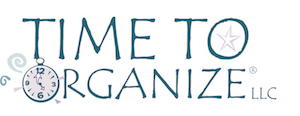professional organizers career tips
Select a company name that will give you a competitive edge
Your company name has a big job to do. It has to help prospective clients find you, whether via the internet or word of mouth. It should succinctly tell prospects what you do. It will create a first impression and an image for your company. And it must stand out in a sea of other professional organizing companies. That’s a lot to ask from a little name, isn’t it? Here’s how to get the most out of yours.
MAKE IT EASY: Your company name should be easy to pronounce, easy to spell, and easy to remember. If it’s hard to pronounce, prospects may move on to the next company name they see. If they can’t spell it, they can’t find you. And if it’s not memorable, well, you get the picture.
CONSIDER HOW YOU’LL ADVERTISE: If your primary advertising source is a directory or roster that’s listed alphabetically, you may want to consider a name that starts at the beginning of the alphabet so you get top placement. If your primary client source is your website, alphabetical listing won’t matter, but your company name should be easy to spell and relatively short. (Avoid using numbers and words that can be spelled multiple ways, and think three words max.)
FIND YOUR CHOICE CLIENT: Let your company name work for you by having it describe what you do, such as having the word “organizing” in your name. If you specialize, your name can help clients narrow down their search. For example, if you offer moving and downsizing services, a name like Easy Moves Organizing makes good sense. Prospects who need moving assistance are likely to contact you because your name instantly tells them that you offer the services they desire. Likewise, if you have a choice client, your company name can help him/her find you. For example, if you want to work solely with children, a name like The Organized Child will give you an edge over your competition. But don’t let your name limit you. If you select Clutter-Free Closets, you’re restricting yourself to closet organizing even if you decide down the road that you love to organize kitchens and home offices.
REMEMBER YOUR IMAGE: Your name is your image. It’s your storefront. It’s your first impression. So remember to keep it neat. Let it reflect your personality — are you fun and friendly or the down-to-business type? Just don’t choose anything too weird or cute, or you’ll regret it down the road. It’s also fine to make your personal name your company name, such as Jennifer Ashley Professional Organizing. Just remember that your name is now part of your image. (But if your name is difficult to pronounce or spell, it may be best to not use it, and know that personal names can be more difficult to remember than something short and snappy.) Also, consider if the name will translate well into a logo. Picture it on your marketing materials, from your business card to your website. If the name is really long, it won’t fit on a business card. If it’s too ambiguous, it may be difficult to create a logo. Think beyond the sound of the name to the image it will create.
MAKE IT UNIQUE: Okay, so this can be tricky with thousands of other professional organizers out there. But it can be done! Start by brainstorming by yourself or with some friends. Write down every single word or phrase that pops into your head. Think nouns, verbs, adjectives, and adverbs! Then review the list, create word combinations, move them around, delete the bad ones, add some new ones, and narrow it down. And in the end, no one needs to love it more than you — not your spouse, your best friend, your sister, or your business advisor. No one knows your business more than you or will have a passion for it. Love it or leave it!
MAKE SURE IT’S AVAILABLE: Once you have a list of five to ten company name options, see if the names are available. As a starting point, if you are a NAPO member, you can do a company name search under the Member Directory to see if anyone else has your desired name(s). Then, you can do a web search for the names via Google. You should also search for nationally-registered names by visiting www.uspto.gov. Click on “trademarks,” “search,” “new users form search,” and enter your proposed company name under “search term.” If someone has registered your desired name (in the same industry), steer clear. If you ignore this “do not trespass” registration warning, you could be forced to give up your company name at a later date. If you find a name that is not in the USPTO registry but is used in a state other than your own, you may be able to use it. But some organizers offer services and products nationwide, so you may be creating confusion if selecting a name already in use. Take the time to find the perfect name that will be unique to you and your business.
[Want a little help naming your organizing business? It’s one of the most important steps in building your new business. Check out The Perfect Name Planning Guide! Click here for info.]
 What Does Success Look Like? That’s Up To The Client!
What Does Success Look Like? That’s Up To The Client!
As you work with your clients, you’ll recognize that each client is unique. There is no one-size-fits-all solution to get a household or office under organizational control. But in order to figure out the best solution, you need to first determine the problem. That’s where a solid assessment comes in. (If you’re unsure how to conduct a proper assessment, check out my book, Born to Organize, for detailed info. You’ll also want to get your hands on my Client Assessment Form to guide you through question-by-question.)
One occasionally overlooked — but very important — part of the assessment is understanding a client’s expectations and goals for your time together. It’s vital to ask, “What does organizational success look like to you?” You might phrase it, “At the end of today’s session (or at the completion of the project), what do you hope we will have accomplished?”
At the beginning of each and every session, I always ask my clients what they would like to accomplish with me that day. This nearly always guarantees a satisfied client! This also cuts down on any possible miscommunication between us. Never assume the most obviously disorganized area is where a client would be most thrilled to tackle. For example, I have a wonderful client I see regularly. Although our sessions usually involved slogging through a build-up of paperwork, we always add on another little area that would make her do a happy dance. It might be clearing out the junk drawer, sorting through a pile of clothing that’s been slung over a bedroom chair, or organizing the front entry closet during seasonal transitions. It’s fun to see what will thrill her each time, but I’d never know unless I asked! By allowing her to define her goals each session, she sets the pace and direction we take.
Of course, there are exceptions. I had one client recently who wanted me and my team member to help clear out her unfinished basement. She had gone through a roller coaster of weight loss and gain over the past years and had dozens of garbage bags full of clothing. She did not want to help with the process, but rather hand it over to us to tackle on our own. After we discussed her goals, she said she’d be happy if we just got through a couple of bags, sorting by size and placing into bins. Of course, I knew we could do better than that, and we sorted clothing for three hours. We got through nearly two dozen bags, sorting them by size and placing them into labeled bins. At the end of the session, we showed her our work, and she seems mildly pleased. But upon email follow-up after the session, she said that we didn’t really accomplish as much as she expected! Lesson learned? You can’t please everyone, even when you define goals ahead of time. But at least I knew that we did what was asked, and we technically exceeded her original expectations.
So, any time you can get a quantifiable metric, the better. You can ask clients, “How much clutter do you ideally want to remove from this room?” Having a rough percentage upfront will help you encourage your clients just the right amount. Another metric might be, “How many rooms do you want to organize?” or “What percent would you like cleared in this space?” Even if the answer is somewhat vague, encourage your clients to visualize what the newly organized space will look like and what it will take to get there. This sets you up for sure success!
Also, it’s helpful to listen for “feeling” words — overwhelmed, stressed, frustrated, embarrassed, alone, busy, unsure — because these words will give you clues to help your clients remedy their quandaries of space, storage, and stuff. You can even ask clients how they want to feel after they are organized. Words like relieved, hopeful, relaxed, happy, free, light, and joyful might give you an idea of their motivators.
The next time you meet with a new client, take some time to ask the right questions and listen carefully. Then, help them define their goals as specifically as possible, ensuring success for both of you!
[Want to learn my tried-and-true organizing process for each room of the house? Check out my book, Learn to Organize. Click here for info.]
national organizing holidays
Use this list to remind yourself of great promotional opportunities throughout the year. These special days are a wonderful opportunity to contact your local media and tell them about any upcoming holidays, with the offer to share organizing tips with their readers/viewers.
JANUARY
Get Organized Month
Be On Purpose Month
Clean Out Your Closets Month
Clean Off Your Desk Day: Second Monday in January
FEBRUARY
Archive Your Files Month
Pay Your Bills Week: Third week in February
Clean Out Your Computer Day: Second Monday in February
Valentine’s Day: February 14
MARCH
Organize Your Home Office Day: Second Tuesday in March
Procrastination Week: Second week of March
Clutter Awareness Week: Third week of March
Clean Out Your Closet Week: Third week of March
APRIL
Stress-Awareness Month
Tax Day: April 15
Organize Your Files Week: Third week of April
National TV-Free Week: Fourth week of April
Administrative Professionals Week: Last week of April
MAY
Moving Month
Scrapbook Month
Revise Your Work Schedule Month
Mother’s Day: Second Sunday in May
Father’s Day: Third Sunday in June
Small Business Week: Second Week in June
JULY
Purposeful Parenting Month
Financial Freedom Day: July 1
Take Charge of Change Week: First week of July
AUGUST
Professional Speakers Month
Simplify Your Life Week: First week of August
SEPTEMBER
ADD/ADHD Month
National Emergency Preparedness Month
Self-Improvement Month
Back-To-School Time
Fight Procrastination Day: First Wednesday in September
OCTOBER
Kitchen and Bath Month
Computer Learning Month
Medical Information Month
Home-Based Business Week: Second week in October
Take Back Your Time Day: October 24
NOVEMBER
Addictions Month
Clean Out Your Refrigerator Month
Pursuit of Happiness Week: Second week in November
Buy Nothing Day: The day after Thanksgiving
America Recycles Day: November 15
DECEMBER
Stress-Free Holidays Month
Make Up Your Mind Day: December 31
[Want more great tips to help you launch or enhance your organizing business? Check out Born to Organize, our professional organizer’s resource book. Click here for info.]
